AMD Zen 4 Ryzen 9 7950X and Ryzen 5 7600X Review: Retaking The High-End
by Ryan Smith & Gavin Bonshor on September 26, 2022 9:00 AM ESTCPU Benchmark Performance: Power, Web, And Science
Our previous set of ‘office’ benchmarks has often been a mix of science and synthetics, so this time we wanted to keep our office section purely on real-world performance. We've also incorporated our power and science testing into this section too.
In this version of our test suite, all the science-focused tests that aren’t ‘simulation’ work are now in our science section. Where possible these benchmarks have been optimized with the latest in vector instructions.
We are using DDR5 memory on the Ryzen 9 7950X and Ryzen 5 7600X, as well as Intel's 12th Gen (Alder Lake) processors at the following settings:
- DDR5-5200 CL44 - Ryzen 7000
- DDR5-4800 (B) CL40 - Intel 12th Gen
All other CPUs such as Ryzen 5000 and 3000 were tested at the relevant JEDEC settings as per the processor's individual memory support with DDR4.
Power
The nature of reporting processor power consumption has become, in part, a dystopian nightmare. Historically the peak power consumption of a processor, as purchased, is given by its Thermal Design Power (TDP, or PL1). For many markets, such as embedded processors, that value of TDP still signifies the peak power consumption. For the processors we test at AnandTech, either desktop, notebook, or enterprise, this is not always the case.
Modern high-performance processors implement a feature called Turbo. This allows, usually for a limited time, a processor to go beyond its rated frequency. Exactly how far the processor goes depends on a few factors, such as the Turbo Power Limit (PL2), whether the peak frequency is hard coded, the thermals, and the power delivery. Turbo can sometimes be very aggressive, allowing power values 2.5x above the rated TDP.
AMD and Intel have different definitions for TDP but are broadly speaking, applied the same. The difference comes from turbo modes, turbo limits, turbo budgets, and how the processors manage that power balance. These topics are 10000-12000 word articles in their own right, and we’ve got a few articles worth reading on the topic.
- Why Intel Processors Draw More Power Than Expected: TDP and Turbo Explained
- Talking TDP, Turbo and Overclocking: An Interview with Intel Fellow Guy Therien
- Reaching for Turbo: Aligning Perception with AMD’s Frequency Metrics
- Intel’s TDP Shenanigans Hurts Everyone
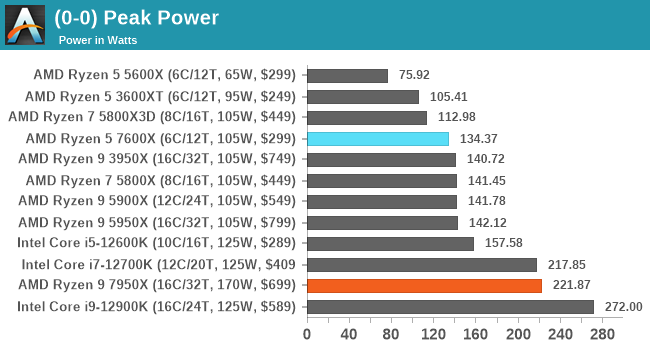
Looking at the results of our Peak Power test, the Ryzen 9 7950X topped out at 221.8 W, which is around 30% higher than the TDP of 170 W it comes with. As stated by AMD, the Power Package Tracking or PPT limit for AM5 motherboards when used with 170W TDP Ryzen 7000 SKUs will be 230 W. Still, while it draws more power than its generational predecessors such as Zen 3 and Zen 2, the Zen 4-based Ryzen 7000 series benefits from higher core clock speeds, a higher single core boost frequency, as well as other implementations around TSMC's 5 nm manufacturing process.
The AMD Ryzen 5 7600X is more aimed at the mid-range, and as such has a lower overall power draw, with the peak power figures in our testing reaching 134.3 W. This is around the same levels of power draw as the Ryzen 9 3950 X, the Ryzen 9 5900X, and the Ryzen 7 5800X. Per AMD's specifications, the Ryzen 5 7600X has a TDP of 105 W, with around a 27 % variance in peak power compared to TDP.
From our testing, so far, it seems that Ryzen 7000 when combined with a premium X670E motherboard allows for up to 30% in terms of extra power allowances for higher single-core boost and overall faster all-core frequencies.
Web
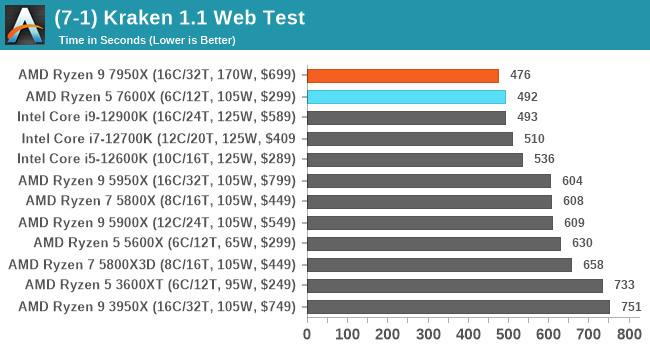
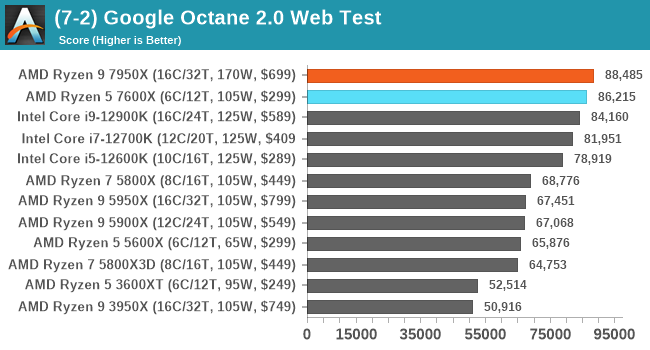
In our web tests, the overall improvements in IPC, frequency, clock speeds, and the switch to DDR5 all play a part in performance here. Both the Ryzen 9 7950X and Ryzen 7 7600X top our charts in regards to web testing, although performance isn't as apparent as it should be in other areas.
Science
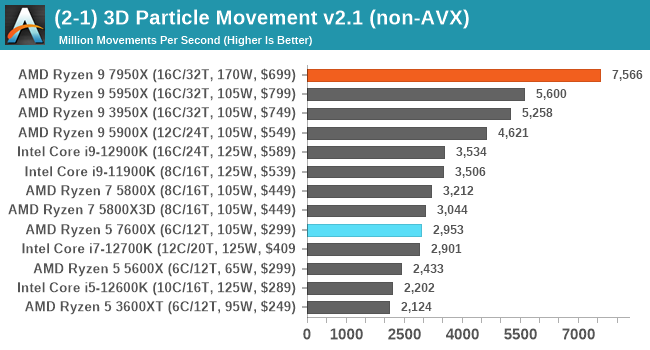
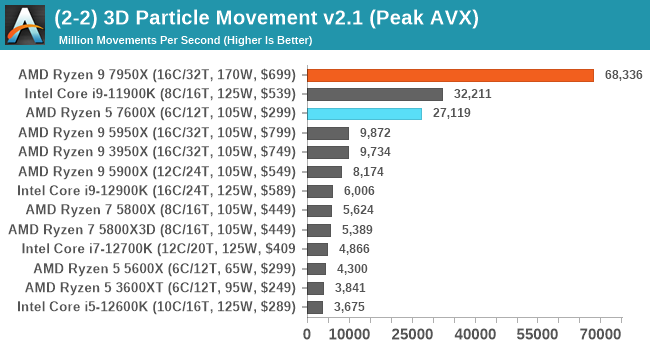
For our 3DPM v2.1 testing, we added in the Intel Core i9-11900K (Rocket Lake) to show performance across AVX workloads. Although Intel officially fused off the AVX2/512 extensions on Alder Lake which did cause a little controversy and gave the impression that AVX-512 on consumer platforms was dead. AMD clearly believes the opposite, as it has implemented it so that AVX-512 runs two cycles over a 256-bit wide instruction. The performance of the Ryzen 9 7950X here is phenomenal, although the Core i9-11900K which did indeed feature AVX instruction sets in the silicon, is still better than the Ryzen 5 7600X with AVX workloads.
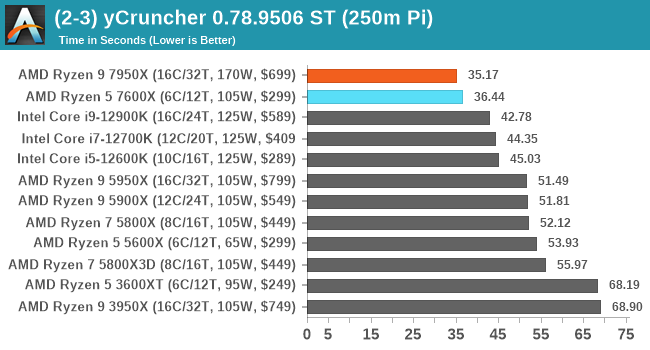
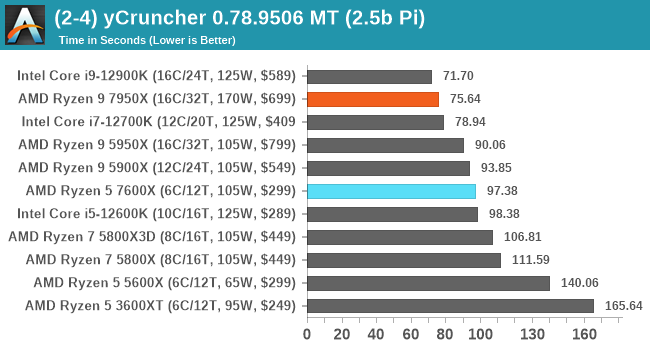
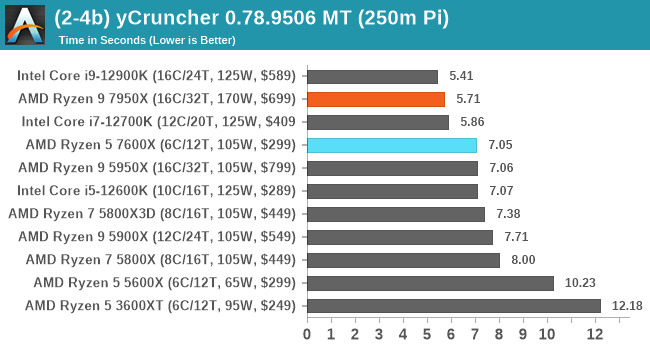
Focusing on our more science-based tests, both the Ryzen 9 7950X and Ryzen 5 7600X perform well against the competition. In our 3DPMv2.1 test in non-AVX, the Ryzen 9 7950X provided a jump of 35% in performance against the previous generation Ryzen 9 5950X processor.
Interestingly, in our yCruncher 0.78 test, the Ryzen 9 7950X and the Core i9-12900K trade blows consistently, although the Ryzen 5 7600X performs well for its price point.










205 Comments
View All Comments
Tom Sunday - Friday, September 30, 2022 - link
Just today received a special sales notice from Micro Center giving away FREE 32GB DDR5 with any purchase of a Ryzen 7000 series CPU. I wonder if AMD is sponsering such a sales push and this early in the game? Giving away a $190 value is a big deal in the trying times of today! ReplyCastillan - Sunday, October 2, 2022 - link
I suspect that's a Microcenter specific deal only. The RAM is 5600 at a fairly high latency (I think it was CAS40?). DDR5 prices have plummeted as well. The memory I picked up from Microcenter was 6600/CAS34 and marked down to 279 from 499.I'd guess that they have a surplus of a certain stock item that wasn't selling, and decided to use this promo to offload unwanted stock and still look good. Reply
imaskar - Friday, September 30, 2022 - link
It would be really great to add code compilation tests: Java, Go, C++ (linux kernel), Rust. Replydizzynosed - Saturday, October 1, 2022 - link
Si what shall I buy? Intel, amd, ??? Which cpu?? I only game. Replyrocky12345 - Saturday, October 1, 2022 - link
What's wrong with the gaming scores on the 7000 series there is no way a 5000 series should be able to match or beat a 7000 AMD CPU. I know this because I have a AMD Ryzen 5900x properly setup and tweaked. AMD is said to have sent DDR5 6000 with the test CPU's and asked the reviewers to use that to test with. Lets face it 97% of the people buying a new AMD Zen 4 setup or Intel 12th gen are not going to be using bargain basement low speed ram and if they do happen to buy cheaper ram most are more than likely to try and run it at the highest speed possible. did I read that right you used CL44 DDR5 5200Mhz talk about dead heading performance.Also maybe I missed it but what was the Intel test system setup? other than that it was a decent review. I never have seen Ryzen 5000 that close in gaming I guess using slow DDR5 knee jerks Ryzen 7000. My own ram is running at CL16 4000Mhz 2000IF and at the reported number in the review if I had the same video card I would be either faster or only slightly slower than the test results here for games and that would give me false hope that my Zen 3 was faster than it really is lol. Reply
Oxford Guy - Sunday, October 2, 2022 - link
The only way you're going to see movement on this is if you lobby AMD to abandon JEDEC.This site sees JEDEC as all there is. Reply
GeoffreyA - Monday, October 3, 2022 - link
I think it's about keeping a common baseline of memory speed, especially since Anandtech's database is about having parts directly comparable. ReplyOxford Guy - Monday, October 10, 2022 - link
That’s not the reason that has been given again and again and it’s a terrible one anyway. The parts are different. The memory that goes best with those parts differs. ReplyGeoffreyA - Tuesday, October 11, 2022 - link
They should have set all the systems to DDR4 3200 and called it a day. Replybyte99 - Sunday, October 2, 2022 - link
I'm a bit confused. When Anandtech was doing their efficiency analysis, it seemed they were taking the 65W Eco mode label as the actual package power, instread of actually measuring it (as they usually do). When Ars Technica measured the package power of the 7950X and 7600X in 65w Eco Mode, they found it was 90W for both.[ https://arstechnica.com/gadgets/2022/09/ryzen-7600... ]
Did Anandtech miss something obvious, or am I missing something? Reply